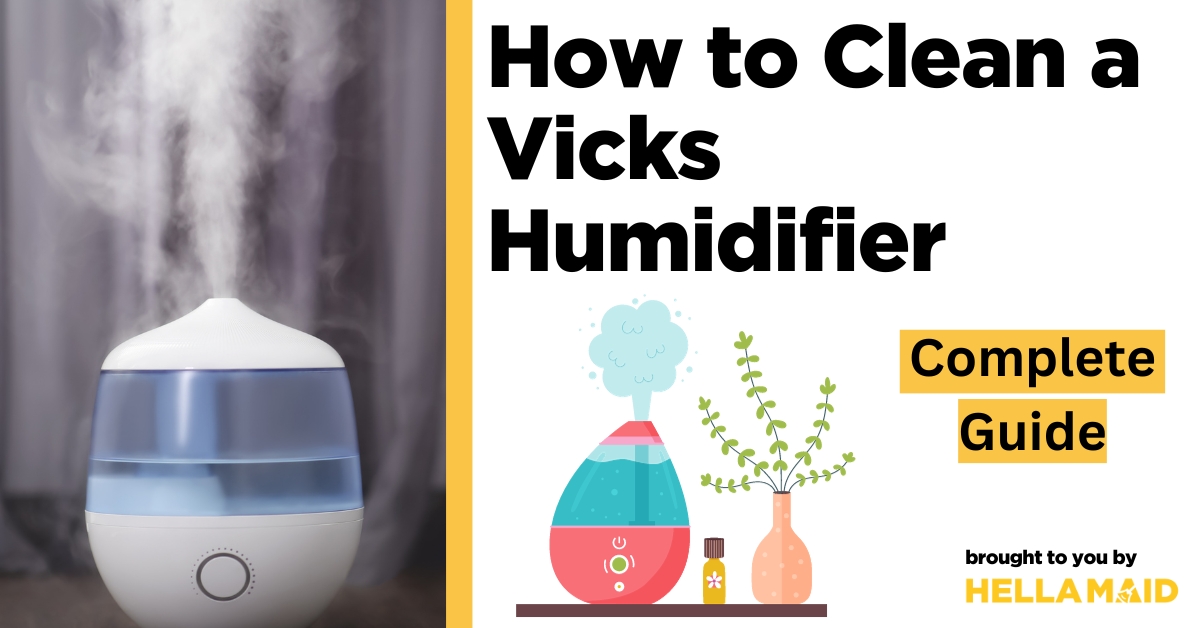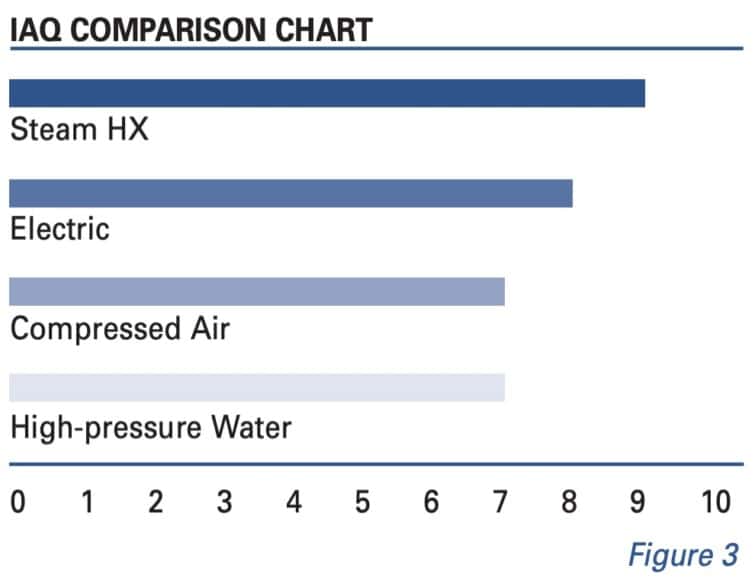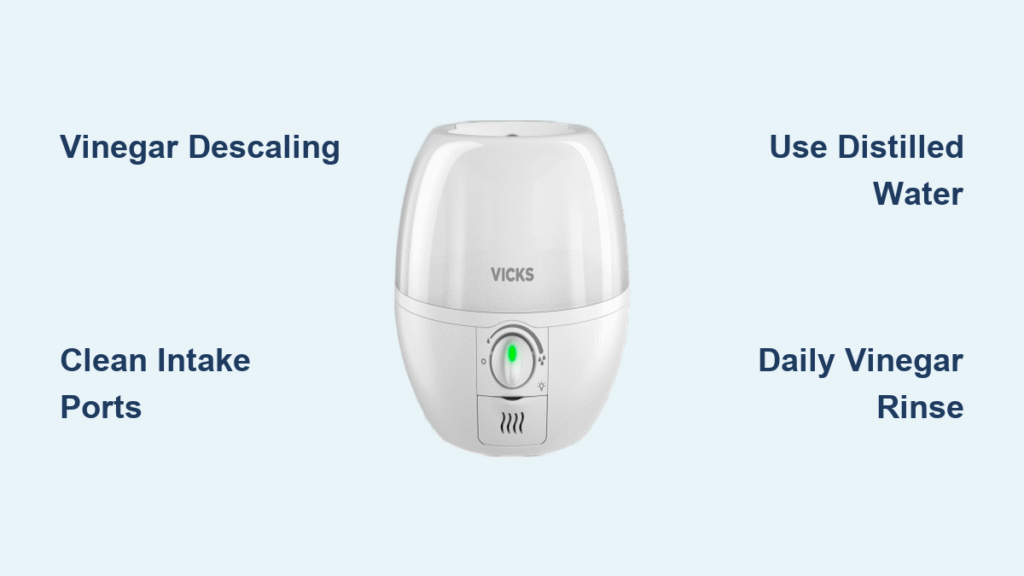Your Vicks humidifier hums along with lights glowing and fan spinning, yet the water level hasn’t budged in hours. That comforting mist that once eased winter dryness has vanished, leaving cracked lips, scratchy throats, and frustration mounting. When your Vicks humidifier not using water despite running normally, mineral clogs are almost always the culprit—blocking vaporization pathways in 9 out of 10 cases. This silent failure wastes energy, risks mold growth from stagnant water, and defeats the entire purpose of owning a humidifier.
Don’t replace your unit just yet. This guide delivers field-tested solutions to revive water consumption in under 30 minutes. You’ll diagnose the exact blockage point, execute a vinegar-powered descaling treatment that dissolves stubborn limescale, and implement a foolproof prevention system. Most users restore full function with basic household items—no technical skills required.
Pinpoint Why Your Vicks Humidifier Stopped Consuming Water
Visible Signs of Vaporization Failure
Watch for these unmistakable red flags when your Vicks humidifier not using water:
– Water level stays identical after 2+ hours of operation (mark it with tape to confirm)
– Zero mist output despite warm air blowing from the vent
– Dry air persists even with humidity settings at maximum
– Normal sounds and lights masking the underlying blockage
10-Minute Diagnostic Protocol
Skip guesswork with this targeted test:
1. Fill the tank to the “Max” line and place tape at the water level
2. Run on high setting for exactly 60 minutes
3. Check for any water reduction—if level remains unchanged, mineral clogs are confirmed
4. Hold your hand 6 inches from the vent—if no moisture lands on skin, vaporization has failed
Critical note: Never run the unit dry during testing. Stop immediately if water drops below 1 inch to prevent heating element damage.
Mineral Clogs: The Silent Killer of Vicks Humidifiers

How Limescale Chokes Water Pathways
Hard water contains dissolved calcium and magnesium that solidify during vaporization. Each use leaves microscopic deposits that accumulate into:
– Rock-like crusts sealing water intake ports
– Chalky obstructions in ultrasonic diaphragm chambers
– Crystalline barriers around heating elements
These deposits worsen exponentially—what starts as minor mist reduction becomes complete water flow failure within weeks in hard water areas.
Why Vicks Models Suffer Most
Vicks humidifiers’ compact vaporization chambers and narrow internal channels trap minerals more aggressively than larger units. Their high-efficiency design creates perfect conditions for scale buildup: heating elements rapidly concentrate minerals, while ultrasonic vibrations accelerate crystal formation in water pathways.
Gather These Exact Supplies Before Starting
Non-Negotiable Cleaning Essentials
- White vinegar (2 cups minimum—never substitutes like apple cider)
- Microfiber cloths (lint-free for residue removal)
- Table salt (2 tbsp for abrasive paste)
- Fresh lemon juice (1 tbsp—bottled lacks potency)
- Cool distilled water (for rinsing—tap water reintroduces minerals)
Precision Tools for Stubborn Blockages
- Soft toothbrush (baby toothbrush heads reach tight channels)
- Cotton swabs (for pinpoint vent cleaning)
- Wooden toothpick (metal tools scratch plastic components)
Execute This Vinegar Descaling Method
Step 1: Mix the Perfect Cleaning Solution
Pour 2 cups white vinegar into the empty water tank, then add cool distilled water to the “Full” line. This 50/50 ratio maximizes mineral dissolution without damaging seals. Never use undiluted vinegar—it corrodes internal components.
Step 2: Run the Critical Cleaning Cycle
Turn on your humidifier and let it operate until water drops to 1 inch above the base (typically 45-60 minutes). The circulating solution dissolves limescale in vaporization channels. Stop immediately when water nears the minimum line—running dry fries the heating element.
Step 3: Triple-Rinse to Eliminate Residue
Drain all vinegar solution, then:
1. Fill tank halfway with cool distilled water
2. Swirl vigorously for 30 seconds
3. Empty completely
4. Repeat twice more
5. Run a final 15-minute cycle with fresh water to purge lingering odors
Manual Cleaning for Severe Mineral Buildup

Craft the Ultimate Limescale Paste
Combine 1 tbsp fresh lemon juice and 2 tbsp table salt into a gritty paste. The citric acid breaks mineral bonds while salt provides safe abrasion—baking soda won’t cut through hardened scale.
Target the 3 Critical Failure Zones
- Water intake ports: Dab paste on toothpick tip, gently scrape interior channels
- Heating element surface: Apply paste with microfiber cloth using circular motions
- Mist outlet vents: Insert cotton swab coated in paste, twist to dislodge crust
Pro tip: Shine a flashlight into compartments to spot hidden white deposits—clean until surfaces gleam like new plastic.
Stop Future Clogs Before They Start
The Daily 30-Second Defense
Add 4 tbsp white vinegar to the tank every time you refill. This maintains a protective acidic layer that prevents minerals from bonding to components. Skip this step, and clogs return within 10 days in hard water areas.
Water Quality Hierarchy for Humidifiers

| Water Type | Mineral Content | Clog Risk | Cost Effectiveness |
|————|—————-|———–|——————-|
| Distilled | Zero | None | ★★★☆☆ |
| Reverse Osmosis | Near-zero | Low | ★★☆☆☆ |
| Filtered (Brita) | Reduced | Moderate | ★★★★☆ |
| Tap (Hard Water) | High | Severe | ★★★★★ |
Always avoid well water or spring water—their high mineral content guarantees rapid clogs.
When Basic Fixes Fail: Advanced Solutions
Diagnose Persistent Blockages
If water still isn’t consumed after descaling:
1. Inspect the float mechanism: Ensure it moves freely (stuck floats disable water flow)
2. Test with distilled water only: Confirms if tap water minerals caused recurring clogs
3. Check fan airflow: Weak suction prevents proper vaporization even with clear channels
Commercial Descaler Decision Guide
Use products like Dri-Eaz Humidifier Cleaner only when:
– Vinegar treatments fail after 3 attempts
– Visible cracks appear in the water tank
– Unit is over 3 years old with heavy usage
Never use CLR or toilet bowl cleaners—they melt plastic components.
Long-Term Performance Guarantee System
Seasonal Storage Protocol
Before storing your humidifier:
1. Run full vinegar cycle with 2 cups solution
2. Air-dry all parts for 48 hours (no direct sunlight)
3. Store in original box with silica gel packets
4. Replace filters/wicks before next season
Water Hardness Monitoring
Test your tap water monthly with $5 test strips. If hardness exceeds 7 grains per gallon, commit to distilled water—it pays for itself by doubling your unit’s lifespan.
Immediate Action Plan: Run 2 cups vinegar + equal water for 45 minutes, rinse 3x, then add 4 tbsp vinegar to every refill. Warning: Ignoring clogs causes permanent damage within 2 months. Success Signal: Water level drops 1/2 inch per hour with visible mist. Most users fix Vicks humidifier not using water issues in one cleaning session—extend your unit’s life for years with this simple routine. Your dry air relief starts now.





